Arch Daily |
- ArchDaily's 2017 Building of the Year Awards are Now Open for Nominations
- Wadi Penthouse / Platau
- Tea House in Li Garden / Atelier Deshaus
- House in Shimokawahara / KOIZUMISEKKEI
- Yi She Mountain Inn. / DL Atelier
- Slack NYC HQ / Snøhetta
- 9 Visions for Lunar Colonies Selected as Winners in Moontopia Competition
- Rural Health Clinic / SAA arquitectura + territorio
- New York City's SeaGlass Carousel, Photographed by Danica O. Kus
- House Cronos / Moirë arquitectos
- Watch Steven Holl Take You on A Tour of the Recently Completed 'Ex of IN' House
- The Green Embassy / Steffen Impgaard
- Why Do We Love GIFs?
- Roberts Pavilion / John Friedman Alice Kimm Architects
- How to Change Cities With Culture: 10 Tips Using UNESCO
- EFFEKT's Winning Proposal Converts Abandoned Warehouse Into Cultural Hub
| ArchDaily's 2017 Building of the Year Awards are Now Open for Nominations Posted: 23 Jan 2017 12:55 AM PST  2016 was a defining year for ArchDaily. The change and uncertainty around the globe which emerged during the past year allowed us to double down on our mission to provide information, knowledge, and tools to architects, leveling the access to architectural knowledge and enabling a more diverse, equitable profession. As part of this, we now have a renewed focus on data-driven decisions and crowdsourcing architecture's understanding of its own work. The flagship of this crowdsourcing effort has always been our annual Building of the Year awards. Now, for the 8th consecutive year, we are tasking our readers with the responsibility of recognizing and rewarding the projects that are making an impact in the profession, with ArchDaily's 2017 Building of the Year Awards. By voting, you are part of an unbiased, distributed network of jurors and peers that has elevated the most relevant projects over the past seven years. Over the next two weeks, your collective intelligence will filter over 3,000 projects down to just 16 stand-outs—the best in each category on ArchDaily. This is your chance to reward the architecture you love by nominating your favorite for the 2017 Building of the Year Awards! Full rules after the break. 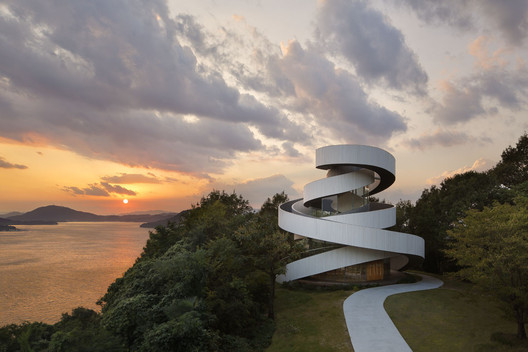 Ribbon Chapel by NAP Architects, winner of the 2016 Religious Architecture Award. Image © Koji Fujii, Nacasa & Partners inc Ribbon Chapel by NAP Architects, winner of the 2016 Religious Architecture Award. Image © Koji Fujii, Nacasa & Partners inc The ProcessDuring the next 2 weeks, you'll be in charge of nominating buildings (in sixteen categories) for the shortlist, and then voting for the winners of each category. We will guide you through these stages accordingly. During the nominating stage, each registered user of the My ArchDaily platform will have the chance to nominate one project (published between January 1st 2016 and December 31st 2016) per category. This stage starts on January 23rd and ends on January 30th at 9:00AM EST. After this, five projects per category will move into the voting stage, starting January 31st and ending on February 6th at 9:00AM EST. The winner will be announced on February 7th, 2017. 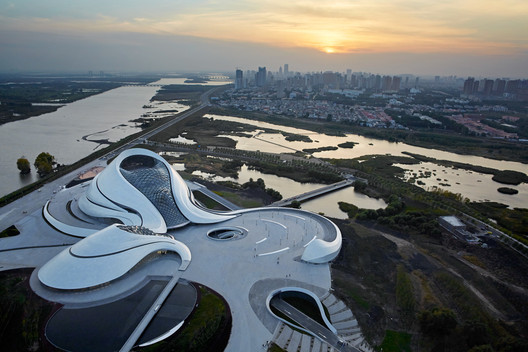 Harbin Opera House by MAD Architects, winner of the 2016 Cultural Architecture Award. Image © Hufton + Crow Harbin Opera House by MAD Architects, winner of the 2016 Cultural Architecture Award. Image © Hufton + Crow Selected Projects
 Vila Matilde House by Terra e Tuma Arquitetos, winner 2016 Houses Award. Image © Pedro Kok Vila Matilde House by Terra e Tuma Arquitetos, winner 2016 Houses Award. Image © Pedro Kok Timeline
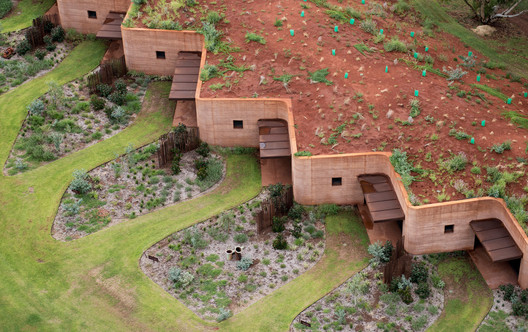 The Great Wall of WA by Luigi Rosselli, winner of the 2016 Housing Award. Image © Edward Birch The Great Wall of WA by Luigi Rosselli, winner of the 2016 Housing Award. Image © Edward Birch Nominating/Voting
http://boty.archdaily.com/us/2017  Matmut Atlantique Stadium by Herzog & de Meuron, winner of the 2016 Sports Architecture Award. Image © Iwan Baan Matmut Atlantique Stadium by Herzog & de Meuron, winner of the 2016 Sports Architecture Award. Image © Iwan Baan First stage: Nominations
 Partners In Health Dormitory by Sharon Davis Design, winner of the 2016 Healthcare Architecture Award. Image © Bruce Engel Partners In Health Dormitory by Sharon Davis Design, winner of the 2016 Healthcare Architecture Award. Image © Bruce Engel Second stage: Voting
 Intesa Sanpaolo Office Building by Renzo Piano Building Workshop, winner of the 2016 Offices Award. Image © Enrico Cano Intesa Sanpaolo Office Building by Renzo Piano Building Workshop, winner of the 2016 Offices Award. Image © Enrico Cano Winners
 Community Kitchen of Terras da Costa by ateliermob + Colectivo Warehouse, winner of the 2016 Public Architecture Award. Image © Fernando Guerra | FG+SG Community Kitchen of Terras da Costa by ateliermob + Colectivo Warehouse, winner of the 2016 Public Architecture Award. Image © Fernando Guerra | FG+SG Important notes
This posting includes an audio/video/photo media file: Download Now |
| Posted: 23 Jan 2017 06:00 PM PST  © Wissam Chaaya © Wissam Chaaya
 © Wissam Chaaya © Wissam Chaaya From the architect. The project is an interior refurbishment of a two floors penthouse for a family of four, located in Wadi Abu Jamil in Beirut Central District. The original arrangement of the penthouse presented a fragmented circulation between its two floors with poor spatial interaction, and a narrow main foyer.  © Wissam Chaaya © Wissam Chaaya The most significant spatial intervention was the introduction of a double height space at the center of the house, reorganizing around it the once fragmented realms of living areas, work areas, storage and bedrooms.  © Wissam Chaaya © Wissam Chaaya Defined by a cladded wooden skin, such element features a widened entrance that transitions smoothly to the reception and brings back to its center the staircase as a feature element.The stairs become a floating structure within such space, suspended from the ceiling through vertical steel profiles that emphasize its lightness and its detachment from skin and slab, as if it's floating in the middle of the double height space.  © Wissam Chaaya © Wissam Chaaya  Ground Floor Plan Ground Floor Plan  © Wissam Chaaya © Wissam Chaaya  First Floor Plan First Floor Plan  © Wissam Chaaya © Wissam Chaaya The wooden skin's form reconciles the different misalignments and provides a curvilinear horizontal and vertical continuity between the widened lobby and adjacent spaces on both floors. This skin integrates doors to adjoiningrooms,storage closets, see through cutouts and incorporated lighting.It turns the corner to maintain the same treatment for the inner living room wall. Steel profiles stick out of the skin to create door handles and shelves. Complementing the minimal materiality, a playful custom made steel and copper lighting fixture hangs from the double height reception.  © Wissam Chaaya © Wissam Chaaya In contrast with its wooden skin core, the remaining surfaces of the penthouse are white paint for walls, white marble for floors and white steel for the staircase. The different rooms are designed with a recurrent system of having the exterior walls painted white and the internal walls with different playful wood cladding to incorporate doors, library and closets.  © Wissam Chaaya © Wissam Chaaya During its development and execution phases, the project became an exploration of the wide array of means for both designing and fabricating architecture on the light on local craftsmanship constraints.  © Wissam Chaaya © Wissam Chaaya This posting includes an audio/video/photo media file: Download Now |
| Tea House in Li Garden / Atelier Deshaus Posted: 23 Jan 2017 02:00 PM PST  © TIAN Fangfang © TIAN Fangfang
 © TIAN Fangfang © TIAN Fangfang The Tea House is located in an approximately 110 m2 little garden, where a tall paulownia stands and covers our little building under its huge crown. Before that, this small place could not be seriously called garden, for it was something residue left by two staircases connecting to the neighboring office. Therefore, how to make the Tea House occupy this space at a minimum level so as to form a garden, becomes a key point in the design process.  Plan Plan We decide to put the building in the northwest corner where the paulownia stands, clinging to the back wall. In doing so, the Tea House would enjoy a relatively complete and large courtyard towards the gate. While at the same time, we cut the volume facing the paulownia into an "L" shape, thus forming a tiny backyard. This backyard functions as an outdoor room complementary to the Tea House. And the thick trunk of the paulownia, almost 90cm in diameter, also becomes a lively actor of the space.  © TIAN Fangfang © TIAN Fangfang  Axonometric Axonometric In order to link the building to the garden without disturbing it, we add three horizontal cantilevers at different heights: the one at 45cm high works as a bench encircling the building both inside and outside; the one at 1.8m high extends the interior space into the courtyard and marks the human scale of the corridor; the roof is the last cantilever. It covers an area of 40 m2 with a ground floor of only 19 m2. It redefines the outer space in the south, north and west, allowing the green space in the garden permeate inside and vice versa.  © TIAN Fangfang © TIAN Fangfang  © TIAN Fangfang © TIAN Fangfang In order to hold this typical perception of a tiny, light Tea House, we choose to use 60mm steel tube in square cross section all over the building. While satisfying structural needs, this element could also have a chance to participate in the formal composition. It is the structural element; meanwhile, it adapts itself to the scale of the furniture, thus establishing a close relationship with human body.  Front Elevation Front Elevation  Section Section The roof is made of 8mm steel board. Its insulation board is fixed by the anti-ribbed steel panel, which is meant to keep the roof smooth. Considering the lighting system and thermal insulation, we make a suspended ceiling hiding the structural beam, while putting the air conditioning system under the floor.  © TIAN Fangfang © TIAN Fangfang This posting includes an audio/video/photo media file: Download Now |
| House in Shimokawahara / KOIZUMISEKKEI Posted: 23 Jan 2017 12:00 PM PST  © Toshiyuki Yano © Toshiyuki Yano
 © Toshiyuki Yano © Toshiyuki Yano From the architect. The project area had the Abe-kawa river bed and row of cherry blossom trees on the north side with the majestic Mt. Fuji in full view beyond that.  © Toshiyuki Yano © Toshiyuki Yano On the other hand, there was a three-story house adjacent to the south side, so it couldn't expect to get much sunlight.  © Toshiyuki Yano © Toshiyuki Yano Under such conditions, we made a wide open wall like a door, and designed it to act as a frame for that beautiful scenery to the north and had connection with the outside.  © Toshiyuki Yano © Toshiyuki Yano In the living room on the second floor, sunlight from a skylight on the third floor shines on the wall that holds lightweight cantilevered stairs.  Section Section This sunlight reflects off the big wall and is designed to allow for the entire living room to be brightened with soft sunlight even without windows on the south side where the adjacent house is located.  © Toshiyuki Yano © Toshiyuki Yano The Japanese characters of the owner's name have the contrasting elements of the moon and the sun. Therefore, we wanted to include contrasting elements into this architecture as well. Thus, we have this beautiful, smooth, white wall on the inside against the rough, exposed, RC wall on the outside. We also have a huge, formidable wall against the large open space of the living room.  © Toshiyuki Yano © Toshiyuki Yano These kinds of contrasts became a very important part of the design concept for the architecture. This posting includes an audio/video/photo media file: Download Now |
| Yi She Mountain Inn. / DL Atelier Posted: 23 Jan 2017 11:00 AM PST  © Sun Haiting © Sun Haiting
 © Sun Haiting © Sun Haiting Over these years, I always go camping with family or friends to deep mountains and forests, to desert or snow land. Those were where we enjoy the broad starlit sky together and keep far away from crowded city life. In the city, people race against precious time, yet time flies so slowly by spending in vain here. We were not swayed by considerations of gain and loss, which help us learn more in the process of wasting time.  Site Plan Site Plan Our Inn lies beside Ming Dynasty Tombs on one hour's drive from Beijing, which is convenient for guests to switch from the bustling city life to quiet seclusion time. Even in the days of haze, you can still see the blue sky here.  © Sun Haiting © Sun Haiting  Diagram 1-Concept Diagram 1-Concept  © Sun Haiting © Sun Haiting This is not a farmhouse offered to taste country life, or a vacation hotel with countless entertainment activities. This is only a simple place to relax and let hair down.  © Sun Haiting © Sun Haiting  Plan Plan  © Sun Haiting © Sun Haiting Fresh food and beverage are offered here. We encourage people to cook, to talk, to interact rather than eat from the menu. The environment was designed to inspire humility, tolerance, enthusiasm and other beautiful emotions.  © Sun Haiting © Sun Haiting On sunny days, this shared kitchen will be activated by sunshine, like an open stage facing the courtyard, the operation table was purposely designed as an island like a hearth, where people can cook together, the chef will be the leading performer facing the audience, who enjoys the cooking itself as well as the praise from viewers.  Diagram 2 Diagram 2 The east part are the guest rooms with different themes and design languages, 5 rooms are sprinkled on an enclosed layout, guests will be facing mountains or lakes from different angles, and therefore feel some sense of relaxation and freedom.Families are most welcome, parents could read in the room and at the same time watch over their kids playing around in the courtyard, each family member will feel the connections in this atmosphere. Meanwhile, the spacial void and valid are interwoven together not only to blur the boundaries of segregation, but also to blur the distance between people.  © Sun Haiting © Sun Haiting There is not grand narrative of architecture or complicated construction method. Only local material as brick and wood are used here, with appropriate adjustment on scale and form. In springs, the brick wall will be covered by climbing plants and wild flowers, the whole courtyard will help people feel the sunlight and the wind. Our Inn, together with the background of mountain and river, offers a gentle atmosphere for guests' aimless leisure life.  © Sun Haiting © Sun Haiting We hope it is a place to feel the passing time and enjoy the comfort of being close to family and friends.  © Sun Haiting © Sun Haiting  Section Section  © Sun Haiting © Sun Haiting This posting includes an audio/video/photo media file: Download Now |
| Posted: 23 Jan 2017 09:00 AM PST  © Michael Grimm © Michael Grimm
 © Michael Grimm © Michael Grimm From the architect. Slack is the fastest-growing workplace software in the world. With over 6 million active weekly users, the intra-office messaging system is revolutionizing the way teams communicate around the globe. For the startup's New York City headquarters, Snøhetta retrofitted a 12,000 SF space on the top floor of an 1880's landmarked building in Lower Manhattan's NoHo/East Village neighborhood to provide a versatile, sunlight-filled office. The design of each of Slack's offices around the world aims to integrate elements of their local context, and Snøhetta's design for Slack's new NYC space is inspired by the city's distinctive urban courtyards. Drawing inspiration from interior parkscapes like Paley Park, bamboo plants provide natural privacy screens and energize the space with greenery. Four existing skylights with enlarged, splayed ceilings dramatically increase the incidence of natural daylight deep into the space and the pocket courtyards beneath them.  © Michael Grimm © Michael Grimm The office's restrained material palette is evocative of an artist's studio space with hints of color, angled plywood panels and custom light fixtures subtly reference Slack's brand identity and imagery. The design represents a maturing tech office typology: Employees are encouraged to venture out of the office for coffee and lunch breaks, and integrate themselves into the neighborhood surrounding Astor Place. Further, underpinning Slack's mission to improve workplace efficiency is its own dedication to the well-being of their employees – an internal motto is "work hard and go home." At the forefront of the next generation of tech offices, the design of Slack's NYC headquarters similarly embodies their commitment to improving workplace communication and culture.  © Michael Grimm © Michael Grimm  Floor Plan Floor Plan  © Michael Grimm © Michael Grimm Upon arrival, employees and visitors pass the reception desk and are welcomed into the social heart of the office, a generous multi-functional 'all-hands' space. Stepped wooden bleachers allow users to gather for large, office-wide meetings and presentations, lunch breaks, or informal meetings while sitting under expansive industrial skylights. An adjacent lounge space is lined with plywood benches also to encourage informal social interaction and spontaneous meetings. A corridor connects these social spaces to the work space and meeting rooms where the Engineering and Accounts teams, the two main groups using the space, sit in an open, flexible plan. A wide variety of workspaces and breakout rooms accommodate the diverse demands of Slack's working environment, including one and two-person telephone booths to provide privacy for calls, as well as for when a more isolated work environment is needed.  © Michael Grimm © Michael Grimm Acoustics and natural light are critical in achieving a successful and comfortable open office space. The existing skylights were subtly shaped to better fill the space with soft, natural light. Regularly spaced throughout the office, they draw the eye upwards and create varied ceiling heights that suggest the spaciousness of an New York loft. As one travels the length of the space, the alternating rhythm of workspace and interior courtyard allows for breaks and moments of pause.  © Michael Grimm © Michael Grimm Acoustics are carefully managed to maximize productivity and communication for each team. Wide planes of glass allow visibility and visual connection through the conference rooms, but are acoustically separated. The non-symmetrical geometry of the meeting rooms minimize sound reflection that function dually to provide unexpected seating ledges on the exterior. The phone booths have been treated with bright, absorptive fabric panels that add a pop of color and element of surprise.  © Michael Grimm © Michael Grimm As a pioneering workplace technology, Slack aims not only to improve efficiency but also to cultivate company culture. By providing a pleasing, simple interface that streamlines workflow and encourages various types of communication, it also strives to help teams build a common sense of company culture. Building on Slack's aspirations to revolutionize the virtual workplace, the design of its new physical work space promotes same values. From carefully managed acoustics and plentiful natural light in the workspaces to pockets for informal gatherings and lush, indoor courtyards, Snøhetta's design allows a variety of social interactions and work styles to flourish.  © Michael Grimm © Michael Grimm This posting includes an audio/video/photo media file: Download Now |
| 9 Visions for Lunar Colonies Selected as Winners in Moontopia Competition Posted: 23 Jan 2017 08:15 AM PST  Moontopia Competition Winner - TEST LAB. Image Courtesy of Eleven-Magazine.com Moontopia Competition Winner - TEST LAB. Image Courtesy of Eleven-Magazine.com Eleven Magazine has announced the winners of the international design competition "Moontopia," which asked architects to imagine a self-sufficient lunar colony designed for living, working, researching and space tourism. From a pool of proposals from hundreds of applicants worldwide, 9 schemes were selected by an expert jury including space-architects, academics and NASA designers as the winners of the competition. Check out the winning projects below. WinnerTEST LAB / Monika Lipinska, Laura Nadine Olivier and Inci Lize Ogun  TEST LAB / Monika Lipinska, Laura Nadine Olivier and Inci Lize Ogun. Image Courtesy of Eleven-Magazine.com TEST LAB / Monika Lipinska, Laura Nadine Olivier and Inci Lize Ogun. Image Courtesy of Eleven-Magazine.com A medium-scale lunar colony, Test Lab invasions a base point in the frontline of space exploration and Lunar colonisation. Beautifully presented in their sheets, this winning team have developed a design which acts as an initial base on the Moon to conduct further testing on our satellite. The architecture can be allowed to grow and construct itself through a method of 3D printed self-assembly, gradually colonising the Moon over time. The most important structure of the Test Lab is the outer membrane. Based on a simple origami pattern and made of programmed carbon fibre, it has the ability to shape itself once it senses pressure variation with the first solar wind.  TEST LAB / Monika Lipinska, Laura Nadine Olivier and Inci Lize Ogun. Image Courtesy of Eleven-Magazine.com TEST LAB / Monika Lipinska, Laura Nadine Olivier and Inci Lize Ogun. Image Courtesy of Eleven-Magazine.com Runner-UpMOMENTUM VIRIUM in L1 / Sergio Bianchi, Jonghak Kim, Simone Fracasso, Alejandro Jorge Velazco Ramirez  MOMENTUM VIRIUM in L1 / Sergio Bianchi, Jonghak Kim, Simone Fracasso, Alejandro Jorge Velazco Ramirez. Image Courtesy of Eleven-Magazine.com MOMENTUM VIRIUM in L1 / Sergio Bianchi, Jonghak Kim, Simone Fracasso, Alejandro Jorge Velazco Ramirez. Image Courtesy of Eleven-Magazine.com For the runner-up team, it was important that the Moon kept a significant meaning for us here on Earth. This is why they decided to base their Moontopia in the lunar orbit rather than on the surface of the Moon itself. A space elevator links the man-made space-city with our beloved natural satellite: a sensitive and elegant solution which mixes poetry with science-fiction.  MOMENTUM VIRIUM in L1 / Sergio Bianchi, Jonghak Kim, Simone Fracasso, Alejandro Jorge Velazco Ramirez. Image Courtesy of Eleven-Magazine.com MOMENTUM VIRIUM in L1 / Sergio Bianchi, Jonghak Kim, Simone Fracasso, Alejandro Jorge Velazco Ramirez. Image Courtesy of Eleven-Magazine.com People's Choice AwardMODULPIA / Alessandro Giorgi, Cai Feng, Siyuan PanEsteban Analuiza  MODULPIA / Alessandro Giorgi, Cai Feng, Siyuan PanEsteban Analuiza. Image Courtesy of Eleven-Magazine.com MODULPIA / Alessandro Giorgi, Cai Feng, Siyuan PanEsteban Analuiza. Image Courtesy of Eleven-Magazine.com The general public's favourite entry is designed as a unique form. According to a so-called aggregation system Weair-Phelan structure, it gives shape to an expandable landscape which could accommodate Moon dwellers in relatively economical, sustainable and simple solutions. Modular in nature, Modulpia could grow organically in time and, by employ bioregenerative strategies, it would be able to provide its own food, plants (for CO2 removal and oxygen production), and generate drinkable water from gray water.  MODULPIA / Alessandro Giorgi, Cai Feng, Siyuan PanEsteban Analuiza. Image Courtesy of Eleven-Magazine.com MODULPIA / Alessandro Giorgi, Cai Feng, Siyuan PanEsteban Analuiza. Image Courtesy of Eleven-Magazine.com Honorable MentionsPLATINUM CITY / Sean Thomas Allen  PLATINUM CITY / Sean Thomas Allen. Image Courtesy of Eleven-Magazine.com PLATINUM CITY / Sean Thomas Allen. Image Courtesy of Eleven-Magazine.com The fantastic graphics of this entry are equally matched by the extensive research which has given birth to its design. In its form alone, Platinum City is a fantasy-driven utopia. In its research, it is a new extraterrestrial urban model based on cutting-edge science and technology available to us today. Could this be a vision of what mankind living on the Moon at a large-scale could actually look like?  PLATINUM CITY / Sean Thomas Allen. Image Courtesy of Eleven-Magazine.com PLATINUM CITY / Sean Thomas Allen. Image Courtesy of Eleven-Magazine.com UPSIDE DOWN / Ryan Tung Wai Yin, Ho Wing Tsit Teresina, Joshua Ho  UPSIDE DOWN / Ryan Tung Wai Yin, Ho Wing Tsit Teresina, Joshua Ho. Image Courtesy of Eleven-Magazine.com UPSIDE DOWN / Ryan Tung Wai Yin, Ho Wing Tsit Teresina, Joshua Ho. Image Courtesy of Eleven-Magazine.com There is clearly a lot of passion, thought and work behind this beautiful design. What makes this proposal so interesting is its phasing. In Upside Down, the design team set out a plan for interplanetary exploration and subsequent colonisation. Their real objective: Mars! The Moon is cleverly used to gather experience and resources... a sort of test-training site for a bigger galactic goal.  UPSIDE DOWN / Ryan Tung Wai Yin, Ho Wing Tsit Teresina, Joshua Ho. Image Courtesy of Eleven-Magazine.com UPSIDE DOWN / Ryan Tung Wai Yin, Ho Wing Tsit Teresina, Joshua Ho. Image Courtesy of Eleven-Magazine.com WOMB / Prapatsorn Sukkaset, Saran Chamroonkul  LOOKING THROUGH THE MOON / Yiling Chu, Yao Ding, Yan-Fei Jiang, Hui Tian. Image Courtesy of Eleven-Magazine.com LOOKING THROUGH THE MOON / Yiling Chu, Yao Ding, Yan-Fei Jiang, Hui Tian. Image Courtesy of Eleven-Magazine.com Womb is an idea. A utopia. A retreat. But one which we can all buy into from time to time. In this design, the Moon becomes an almost ego-less meditation ground. An escape from the hustle and bustle of everyday life on Earth which drowns our senses and generates stress. In Womb, the Moon becomes a place of contemplation, where mankind can seek solace for deeper meanings in human consciousness. And for those times when meditation and contemplation is all but a little too much, then WOMB provides a space-motel catering for the perhaps more 'animalistic' human needs.  LOOKING THROUGH THE MOON / Yiling Chu, Yao Ding, Yan-Fei Jiang, Hui Tian. Image Courtesy of Eleven-Magazine.com LOOKING THROUGH THE MOON / Yiling Chu, Yao Ding, Yan-Fei Jiang, Hui Tian. Image Courtesy of Eleven-Magazine.com LOOKING THROUGH THE MOON / Yiling Chu, Yao Ding, Yan-Fei Jiang, Hui Tian  WOMB / Prapatsorn Sukkaset, Saran Chamroonkul. Image Courtesy of Eleven-Magazine.com WOMB / Prapatsorn Sukkaset, Saran Chamroonkul. Image Courtesy of Eleven-Magazine.com If pioneering 19th and early 20th century town planners (think Ebenezer Howard's Garden Cities for example) would have been catapulted to the contemporary time and asked to design their ideal city on the Moon, they would have designed this wonderful entry. Placed in a natural crater and given an atmosphere of its own thanks to a see-through canopy (called a Solar Dome), this Moontopia is a fully functional city designed to bring a bit of earthly comforts to the Moon.  WOMB / Prapatsorn Sukkaset, Saran Chamroonkul. Image Courtesy of Eleven-Magazine.com WOMB / Prapatsorn Sukkaset, Saran Chamroonkul. Image Courtesy of Eleven-Magazine.com LUNAR OASIS / Edward Chew  LUNAR OASIS / Edward Chew. Image Courtesy of Eleven-Magazine.com LUNAR OASIS / Edward Chew. Image Courtesy of Eleven-Magazine.com Lunar Oasis is a system of colonising barren and hostile territories such as the Moon. It is not built with the aim of establishing a static perfection, but rather designed to allow for natural processes to evolve in time. Thanks to an emphasis on greenery and vegetation, Lunar Oasis is a biophilic sanctuary that reconnects lunar inhabitants back with Earthly nature and provides an alternative to the outside world of barren moonscape. In doing so, the oasis becomes a life-support for human life on the Moon.  LUNAR OASIS / Edward Chew. Image Courtesy of Eleven-Magazine.com LUNAR OASIS / Edward Chew. Image Courtesy of Eleven-Magazine.com THE AEROSPHERE / Stephanie Stiers  THE AEROSPHERE / Stephanie Stiers. Image Courtesy of Eleven-Magazine.com THE AEROSPHERE / Stephanie Stiers. Image Courtesy of Eleven-Magazine.com In scale, the Aerosphere is a tiny shelter, the smallest of all of the Moontopias submitted through this competition. In concept, however, it is huge! This interpretation of Moontopia focuses on Space Tourism. It designs a one-person transportable pod-suit which acts as a life-support and companion for its user adapting and catering to his or her every need. With the Aerosphere, you become a lunar explorer, allowed to explore our satellite through a series of tourists routes set out on the Moon. Can't you just imagine the likes of Richard Branson producing these fun little suites for his space tourists in a few years time?  THE AEROSPHERE / Stephanie Stiers. Image Courtesy of Eleven-Magazine.com THE AEROSPHERE / Stephanie Stiers. Image Courtesy of Eleven-Magazine.com Learn more about the Moontopia competition, here. News and project descriptions via Eleven Magazine. This posting includes an audio/video/photo media file: Download Now |
| Rural Health Clinic / SAA arquitectura + territorio Posted: 23 Jan 2017 07:00 AM PST  © Sergio Araneda © Sergio Araneda
 © Sergio Araneda © Sergio Araneda From the architect. The Project is located in Caleta El Sauce, a coastal enclave in the province of Ovalle, north of Fray Jorge National Park. The local population, which is essentially dedicated to fishing and seaweed collection, receives a medical round every 30 days. The project consisted of a temporary installation aimed at receiving and supporting the visiting doctors, as well as providing a social platform from which the landscape is embraced.  © Sergio Araneda © Sergio Araneda Given the high degree of difficulty in accessing the site, it was decided to develop the Project with a design that included a pre-constructed system that could be setup on site. Both the layout of the medical room as well was the exterior extension as a common space, were designed in such a way as to make relocation to the site possible and facilitate placement, reducing construction time to just 7 days.  © Sergio Araneda © Sergio Araneda The absence of services such as potable water and electricity necessitated the self-sufficiency of equipment, which was resolved through a tower-based apparatus of installations that provided a functional solution to the usage requirements of the clinic. A support shed for the common spaces, water tank and drain, photovoltaic panels for lighting and charging basic equipment, plus a small storage space, were included.  Floor Plan Floor Plan Site layout was determined in relation to achieving a connection with the sea, while also generating connectivity with existing homes, but which, given its scale, was capable of projecting itself toward the coast as just another element of the landscape.  © Sergio Araneda © Sergio Araneda  Sections and Details Sections and Details  © Sergio Araneda © Sergio Araneda This posting includes an audio/video/photo media file: Download Now |
| New York City's SeaGlass Carousel, Photographed by Danica O. Kus Posted: 23 Jan 2017 06:00 AM PST  © Danica O. Kus © Danica O. Kus In this latest photoseries, architectural photographer Danica O. Kus takes her lens inside New York City's SeaGlass Carousel, designed by WXY Architecture + Urban Design with artist George Tsypin. Completed in summer 2015, the 2,575 square foot nautilus-shaped pavilion has become a new attraction within a Piet Oudolf-designed landscape in Battery Park, drawing in visitors with an immersive LED and audio experience inspired by bioluminescent organisms found deep within the ocean.  © Danica O. Kus © Danica O. Kus  © Danica O. Kus © Danica O. Kus  © Danica O. Kus © Danica O. Kus  © Danica O. Kus © Danica O. Kus  © Danica O. Kus © Danica O. Kus  © Danica O. Kus © Danica O. Kus  © Danica O. Kus © Danica O. Kus  © Danica O. Kus © Danica O. Kus  © Danica O. Kus © Danica O. Kus  © Danica O. Kus © Danica O. Kus  © Danica O. Kus © Danica O. Kus  © Danica O. Kus © Danica O. Kus  © Danica O. Kus © Danica O. Kus  © Danica O. Kus © Danica O. Kus Learn more about the SeaGlass Carousel, here. This posting includes an audio/video/photo media file: Download Now |
| House Cronos / Moirë arquitectos Posted: 23 Jan 2017 05:00 AM PST .jpg?1484705750) © Ramiro Sosa © Ramiro Sosa
.jpg?1484705357) © Ramiro Sosa © Ramiro Sosa From the architect. The House Cronos is located in Pinamar, atlantic coast of the province of Buenos Aires. The project responds to the need to build a holiday home for summer and winter in full contact with nature.
The land is in its natural state, presents a significant amount of typical conifers of the area, a sandy soil and visuals open to the forest. The House Cronos seeks to manifest a way of understanding and living a holiday home, based on contact with light and nature, flexibility and quality of spaces, the nobility of technique and materials and the search for an image that reflect its own contemporaneity. .jpg?1484705708) © Ramiro Sosa © Ramiro Sosa  Section Section From these premises the house is defined. The morphology is solved as an addition of volumes that pretend to enter in the forest, generating different visuals and protecting from the winds of the west. .jpg?1484705657) © Ramiro Sosa © Ramiro Sosa Likewise, the purity of the white of these volumes, bursts into the landscape seeking to generate a contrast that values both the nature of the forest and the artificiality of architecture. The organization of the rooms allows to take advantage of natural light and cross ventilation and at the same time generate expansions in the public areas of the house towards the best orientations and visuals .jpg?1484705721) © Ramiro Sosa © Ramiro Sosa The house rises on piles separating from the ground, strengthening the contrast between the house and the landscape, generating the least impact on the land. The project is materialized with steel framing construction system, the envelope is composed of several layers, each of which meets different technical needs (waterproof, thermal, wind, etc.) The choice of the construction system and termination materials allow to strengthen contemporary aesthetics, obtain excellent technical, minor .jpg?1484705734) © Ramiro Sosa © Ramiro Sosa construction times, decrease on-site waste generation and impact on the ground. .jpg?1484705607) © Ramiro Sosa © Ramiro Sosa The outer enclosure in both the walls and the cover is solved with white corrugated sheet. The openings are made of white aluminum. The floors of the public areas interior and exterior, as well as the doors, are wooden. The interior spaces are characterized by the contrast between the preponderance of neutral tones and details in colors. .jpg?1484705506) © Ramiro Sosa © Ramiro Sosa This posting includes an audio/video/photo media file: Download Now |
| Watch Steven Holl Take You on A Tour of the Recently Completed 'Ex of IN' House Posted: 23 Jan 2017 04:00 AM PST 
In this video by directors Spirit of Space, architects Steven Holl & Dimitra Tsachrelia explain the core concepts and exploratory mission driving the architecture of the firm's recently completed Ex of IN House. Watch as the architects lead you through the home's unique layout and construction, describing how the house "explores a language of space, aimed at inner spatial energy strongly bound to the ecology of the place - questioning current clichés of architectural language and commercial practice." Check out the video on vimeo, here. Video via Steven Holl Architects. Ex of In House / Steven Holl Architects This posting includes an audio/video/photo media file: Download Now |
| The Green Embassy / Steffen Impgaard Posted: 23 Jan 2017 03:00 AM PST  © Kirstine Mengel © Kirstine Mengel
 © Kirstine Mengel © Kirstine Mengel  Site Plan Site Plan The Green Embassy is intended as an architectural framework and venue in urban space, to increase the visibility and accessibility of the project Taste Aarhus. With the project Taste Aarhus will create more opportunities for the citizen to get started to grow, even if they do not have a garden. At the same time they invite to do the city's public spaces more palatable, both for the benefit of yourself and other people of Aarhus. The pavilion will be on location for a 2 year period and then moved to another location in the city.  © Kirstine Mengel © Kirstine Mengel  Section Section  Section Section The project will literally make urban spaces edible and thereby affect food culture, improve health and ensure the grounding of citizens. Citizens need to plant, pick, taste and enjoy the sight of fruit trees and vegetables throughout Aarhus city and municipality. The Green Embassy is to act as an open, dynamic and creative workshop for citizens and stakeholders while being headquarter to the team behind the taste of Aarhus.  © Kirstine Mengel © Kirstine Mengel  Isometric Isometric The Green Embassy is designed as the natural center for Taste Aarhus - the first seed meeting space in the city center. The pavilion sensuality and transparency attract attention, interest and with an expected inner universe of activities to stimulate curiosity. Architecturally, the pavilion one rethought use of nature's willow, which in interaction with the urban context and other more high tech building materials such as ETFE, it is a underline the capabilities of nature's building blocks.  © Kirstine Mengel © Kirstine Mengel  Elevation Elevation The design filters the light and creates a lively, changing play of light and shadow which, in interaction with wood creates a warm ambience. With the natural values at the site and the surroundings, the pavilion appears strong and recognizable among the other grandiloquent buildings at the plaza.  © Kirstine Mengel © Kirstine Mengel The seed is used as a metaphor for the new initiative to make the city sensuous and palatable. For this is where it all starts; with a single seed may be allowed to germinate. The expression is enhanced by the use of woven willow sticks as exterior siding. This honesty about the embassy's origin and purpose is both inspiring and compelling and manages to create a curiosity by being able to create a single universe in the middle of the city. The symbiosis between narrative and architecture appear particularly strong through its basic attitude to nature's own growth and embassy functional development. The pavilion manages to create its own identity without being offensive on its both urban and landscape context. The Green Embassy is a visionary pavilion both in its architecture and its function, and changes the way we look at willow as a building material and the city's options.  © Kirstine Mengel © Kirstine Mengel This posting includes an audio/video/photo media file: Download Now |
| Posted: 23 Jan 2017 01:30 AM PST GIFs are hugely popular and are constantly being shared on the Internet by lots of people. Whether it's expressing some feeling that seems unexplainable with words, freaking out over fluffy cats, endless memes or even hypnotic scenes from movies we love (like the above scene from Jacques Tati's "Mon Oncle"). We see the use of this format increasing in Architecture, and one thing is for certain, we love it. To better understand this type of file, let's start by explaining what a Graphics Interchange Format (GIF) is. When we exchange images over the Internet, we generally use file formats that reduce the amount of data stored, eg. .jpeg, .gif, or .png. This makes it so the data stream becomes faster and more versatile, but there's always a loss of quality that comes from the amount of colors or pixels. Hoping to increase the effectiveness of sending graphics files CompuServe, one of the first companies in the world to provide Internet connectivity which later merged with America Online (AOL), was responsible for the creation of GIF in 1987. This replaced their existing format RLE (Run-length Encoding) that offered compression with only two colors, black and white. The new format offered by the company allowed relatively large images to be downloaded in a reasonable time, considering the connections of the time. But what interests us the most about this format that has become so widespread today is the possibility to create animations by adding a series of static images. It was thanks to this characteristic that the GIF became well known mostly for how it was used in the Netscape logo, which was, at that time (1993), the only browser that supported the format. In 1997, web developer John Woodell developed a method of converting videos into GIFs and ended up creating what was probably the first GIF to ever go viral, the Dancing Baby, which was made from a video created in 3D by the developers of Character Studio. That same year Olia Lialina, a pioneer in web-art, installed a series called "My boyfriend came back from the war. After dinner they left us alone." According to an interview published in The Daily Dot, Olia preferred to work with videos, but the GIF format was the only way to have a moving image in an Internet browser. Since then, many other artists have been developing short animations in various styles that take up just a little too much time of our day. Check them out: Lacey Micallef, a former preschool teacher who decided to take up pixel art. Yang Hua Chun, a Chinese guy smitten with animations made from hand-drawn drawings. The aesthetics of Uno Moralez's old games. The Annlin Chao's moving illustrations. Processing GIFs by Dave Whyte. Graphic artist and animation director Nicolas Ménard. Recreations of the classic movie scenes by the artist Bruno Alberto. Architectural drawings from Vapor 324. There's another kind of GIF that leaves us hypnotized. Those that describe items that we use every day and how they work. As well as explaining the mechanisms of a lock or sewing machine, in architecture we can use GIFs to quickly explain, with movement, specific functionalities or processes of a project, a structural fit, transforming a facade or a series of diagrams that show the process of a project. The power of this tool lies in knowing how to sequence the images, setting up an intelligent script that, in a loop, can tell a short story about your building. For some time now we have been encouraging architects to create GIFs about submitted projects and we see a considerable difference understanding their works. Here are some published examples: Both sides of each tower incorporate 14.5 m (47.5 ft) diameter, retractable sunshades for the Media Headquarters Buildings / REX.
The installation is shown in parts in the Nautilus / TEN + NGO City Creative Network project.
Plants designed as Pac-Man scenery made for Osolzip / B.U.S Architecture project.
The axonometric explaining interventions: Apartment 107N / BLOCO Architects.
Perot Museum of Nature and Science / Morphosis.
Tozzer Anthropology Building - Harvard / Kennedy & Violich Architecture
Another equally effective way of creating small stories is through photographic sequences or short stretches of videos. Here the images show simple movements, but it would take several mouse clicks to get the desired effect.
Capilla San Bernardo / Nicolás Campodonico
20th St. / Mork-Ulnes Architects
Cubes House / Studio [+] Valéria Gontijo
Safe House / Robert Konieczny KWK Promes
Green House / Sean Godsell Architects
"Real Seminario de Bergara" / VAUMM
See below for a simple explanation on how to make a GIF in Photoshop from sequential images.
We may never understand why we like GIFs so much. It may be the way scenes are cut into very short stories, interesting themes, colors or the infinite repetition of a few frames, but what we know for sure is that in addition to being fun and beautiful, they can be very useful for presenting a project. Finally, we leave you with these architectural wonders below. Antidote to Modernism: Feifei Feng's Bespoke Intervention on Slab Housing in Jinan
The Axel de Stampa GIFs
GIFs by Michael William Lester
GIFs by Luke Shepard
Want more GIFs? See below for more great architectural GIFs as well as some tips: 7 Ways to Use Animated GIFs to Improve Your Project Presentation How to Create Animated GIFs in Revit References: This posting includes an audio/video/photo media file: Download Now |
| Roberts Pavilion / John Friedman Alice Kimm Architects Posted: 23 Jan 2017 12:30 AM PST  © Fotoworks/Benny Chan © Fotoworks/Benny Chan
 © Fotoworks/Benny Chan © Fotoworks/Benny Chan With Claremont McKenna College's new Roberts Pavilion, John Friedman Alice Kimm Architects (JFAK) has dramatically redefined what a college athletic venue can be, designing an iconic social hub that brings students and faculty together while demarking a new gateway for the campus that reacts to the push and pull of surrounding buildings, playing fields, and aquatic center.  © Fotoworks/Benny Chan © Fotoworks/Benny Chan Roberts Pavilion bends and warps, slants, rises, and sinks with movement and expansive light. To meet the challenges of a compact site, the architects sank the central basketball arena below grade and placed other functions around the edges. The experience of the building is one of lightness and light. Lightness because it appears to hover above the ground plane on a ring of light produced by twelve-foot high sheets of glass on all sides. Light because it is a study in how to optimize daylighting and connects to the world outside with views clear through and from almost any vantage point. For JFAK, light is as much a substance to build with as any other material.  © Fotoworks/Benny Chan © Fotoworks/Benny Chan "We wanted the light to be extraordinary," says John Friedman, principal-in-charge. "When you walk in the lobby you can see into the arena, across the arena, and then out to the track and field and the mountains beyond. You can even look through the building, through four layers of glass, and see the pool on the other side."  © Fotoworks/Benny Chan © Fotoworks/Benny Chan  Diagram Diagram The dynamic geometry makes it a thrilling object of curiosity on an otherwise mostly uniform campus. But this is a living object, full of surprises at every turn and inviting, flexible spaces of repose as well as spontaneity. While originally designed for athletics and recreation, upon opening this June, it is already becoming apparent that members of the Claremont community have others ideas about how to use it, appropriating spaces for study sessions, meetings, and social gatherings. Roberts Pavilion, while near the edge of this suburban commuter campus, has become the new center of campus life.  © Fotoworks/Benny Chan © Fotoworks/Benny Chan "We wanted this to be a special environment," says Friedman, "a place where people would want to spend their entire day and a building unlike any other on campus." The sculptural form of the building is at once an expression of athleticism and the energy of activity happening within its unexpectedly sunken arena, its gym, weight room, fitness center and studios. It is also home to Claremont's Sports Medicine program.  © Fotoworks/Benny Chan © Fotoworks/Benny Chan On the exterior, the building is skinned in terracotta, a cladding system more common in Europe, but the owners liked it for its texture and light appearance. Red and yellow accents dance around the faces of the building to indicate school and team colors. Adjacent to the main entrance, a welcoming landscape stair brings people up to the second level and provides terraced seating. Inside the expansive, vaulted lobby, a double-height, figured wall rises above the dramatic sculptural interior stair, featuring letters in relief that, when put together, spell out the name of the school as well as the school's three core values: Courage. Creativity. Empathy.  © Fotoworks/Benny Chan © Fotoworks/Benny Chan This posting includes an audio/video/photo media file: Download Now |
| How to Change Cities With Culture: 10 Tips Using UNESCO Posted: 23 Jan 2017 12:00 AM PST  "The Old Bridge in Mostar, Bosnia and Herzegovina / Photo: ru.wikipedia.org". Image Courtesy of Strelka Magazine "The Old Bridge in Mostar, Bosnia and Herzegovina / Photo: ru.wikipedia.org". Image Courtesy of Strelka Magazine This article, written by Svetlana Kondratyeva and translated by Olga Baltsatu for Strelka Magazine, examines the most interesting cases of the role of culture in sustainable urban development based on the UNESCO report. UNESCO published the Global Report on Culture for Sustainable Urban Development in the fall of 2016. Two UN events stimulated its creation: a document entitled Transforming our World: the 2030 Agenda for Sustainable Development, which emphasizes seventeen global goals for future international collaboration, was signed in September of 2015 at the Summit in New York. Habitat III, the conference held once in twenty years and dedicated to housing and sustainable urban development, took place in Ecuador in October of 2016. The question of culture's role in urban development, and what problems it can solve, was raised at both events. To answer it, UNESCO summarized global experience and included successful cases of landscaping, cultural politics, events, and initiatives from different corners of the world in the report.  The experts of the Strelka Institute researched the post-Soviet space by examining eleven countries of Eastern Europe and Central Asia. Here are ten of the most outstanding casestudies. 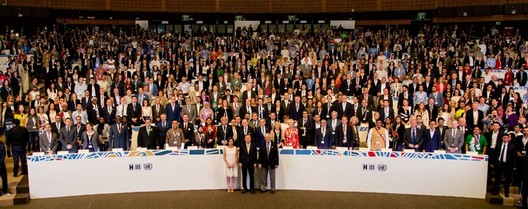 "Habitat III Conference / photo: Facebook". Image Courtesy of Strelka Magazine "Habitat III Conference / photo: Facebook". Image Courtesy of Strelka Magazine About the ReportThe report is divided into two parts: the first consists of regional research conducted along with partner institutions. The countries were divided into eight areas based on geographical and historical commonality. The first one included the territory of Africa (with the exception of its northern counties). Tunisia, Algeria, Libya, Syria, Mauritania and Morocco, along with the Arabian Peninsula represented the second area. Europe was the third; the fourth was formed by Russia and the territory of the former USSR with the exception of Lithuania, Latvia, and Estonia. The fifth region combined the South Asian countries: India, Iran, Pakistan, Sri Lanka, Afghanistan, Nepal, and others. The sixth included Australia, New Zealand, South-Eastern and Eastern Asia. North and South America were the last two areas. For each area, there was a short overview showing what influenced their cultural distinctiveness and how it is being developed now. The second, thematic part of the report was dedicated to twelve issues concerning urban dwellers, the environment, and politics. For example, it contained a consideration of the people-oriented approach to city development, the quality of the environment, and the development of connections between urban and rural areas.  "China-Town, Sydney / photo: Istockphoto.com". Image Courtesy of Strelka Magazine "China-Town, Sydney / photo: Istockphoto.com". Image Courtesy of Strelka Magazine Culture and Immigration: Why Save Chinatown and Rehabilitate Music?Steven Vertovec, head of the Max Planck Institute for the Study of Religious and Ethnic Diversity, points out some interesting changes in the subject of migration and urban processes associated with it. According to him, processes of overpopulation now happen more rapidly than ever before. They create stable flows of ideas, symbols, and meanings that are being transferred between countries and continents. Also, a new phenomenon has appeared: migrants demand equal rights and opportunities for participation in social life in the new location very actively and sometimes even aggressively. Based on these observations, Vertovec speaks of a new term: "super-diversity". The key distinction of this phenomenon lies is the fact that the newcomers mostly live in the same districts as the migrants from previous waves and generations. As a result, we get a territory with multilayered cultural and social features, which still opposes itself to the main, official culture of the city. On one hand, this results in segregation and conflicts. On the other hand, this can encourage the creation of new methods of cooperation and cosmopolitan practices. For example, Vancouver, which doesn't have a single ethnic group that amounts to more than 25% of the population, has translated basic important public documents into several languages and implemented multilingual phone lines. The Diverse Communities and Multiculturalism strategy, which helps the newcomers to adapt, was developed in the city. It also has initiatives set up to support LGBT communities, fight racism and discrimination, and fortify mutual understanding between natives and immigrants. The case of Sydney shows how a "Chinatown's" status can change. Chinatown in the Haymarket district was basically considered an immigrant ghetto until the 1970s; then people started rethinking its role. In 1980 two arches in the Chinese style, traditional red lanterns and other Eastern paraphernalia were set up at the initiative of the government and business community. Thus, "immigrant" culture found a way of formal expression. However, a new problem appeared in the 21st century: gentrification and the threat of loss of identity. The Chinatown Public Domain Plan program was developed in 2010 to preserve the historical district. It aimed to "respect, protect and build on the area's historic links with Chinese culture and the Chinese community, together with the growing influence of other Asian cultures and communities, while recognizing the area's importance to contributing to the vitality and diversity of Sydney as a global City." In 2006. Uruguay had to not just recognize immigrant culture but also, in a way, regenerate it. That year the government of Montevideo suggested a new annual holiday, National Candombe Day, dedicated to Afro-Uruguayan culture and racial justice. It celebrates the Candombe music style, which came from Africa. Historically it had been treated as a part of slave culture, and immigrants who wanted to improve their position in a new country even tried to distance themselves from their own traditions. The new holiday was meant to change these associations with Candombe. A few years later it was recognized on a global scale: UNESCO added this style to the list of Intangible Cultural Heritage in 2009.  "National Candombe Day, Montevideo, Uruguay / Photo: Istockphoto.com". Image Courtesy of Strelka Magazine "National Candombe Day, Montevideo, Uruguay / Photo: Istockphoto.com". Image Courtesy of Strelka Magazine Culture and Conflicts: Reconstruction as a Symbol of Peace and Tragedy MuseumsLately, a wave of mass destruction of historical landmarks has taken place in certain countries that are involved in military conflicts. Such losses usually undermine the morale of the population, who have lost part of their tangible history and identity. However, it can also become an incentive for unification and the revival of traditions. Timbuktu, a city in Mali, is a great example. Its mosques and adobe houses were included in the UNESCO list in 1989. But the city was badly damaged during the armed uprising in 2012: fourteen out of sixteen mausoleums with tombs of the saints were destroyed, museums and libraries looted, unique manuscripts burnt. Both international specialists and local citizens were invited to participate in the reconstruction of the landmarks after the city's liberation. As a result, some citizens were taught traditional construction techniques, which means that this unique historical knowledge was actualized. Interestingly, reconstruction of landmarks damaged in conflicts sometimes costs more than the landmarks themselves. The Old Bridge—a 16th Century landmark—was destroyed in Mostar (Bosnia and Herzegovina) in 1993 during the Croat-Bosniak War. The construction was a symbol of the peaceful life of the multinational population of the city and the country, which led to its destruction. During the reconstruction work, the fallen pieces of old buildings were raised from the bottom of the river and reused. Stone was also obtained from local quarries. The bridge was opened in 2004 and a year later it was added to the UNESCO List of World Heritage in recognition of its great symbolic significance. Conflicts also have an opposite side: sometimes they give cities new landmarks and practices and solidify their identity. In their description of southern African countries that experienced liberation movements and changes of government, the authors of the report allocate this kind of heritage to a separate category. It includes uprising squares, former prisons, and dictators' palaces. The District Six Museum, opened in Cape Town in 1994, represents another similar case. It is dedicated to the period of apartheid and the forced transportation of 60,000 local citizens. The exposition presents the map of the area with handwritten notes from former occupants, indicating the location of their homes and old street signs, and also stories of the relocated families. The museum has become both a landmark of the tragedy and the meeting point for those who identify themselves with the district's history.  "Paris beaches / Photo: Istockphoto.com". Image Courtesy of Strelka Magazine "Paris beaches / Photo: Istockphoto.com". Image Courtesy of Strelka Magazine Public Spaces: Culture in the Ghetto, a Former Prison and on the SquareA lot of interesting cases from the UNESCO research address the opportunities to influence the welfare, image, and economy of specific areas using public spaces. For example, traffic is limited on the Siena embankment in Paris during the summertime so that recreation areas can be organized. The first such area was set up in 2002 on the mayor's initiative. According to him, a recreation area by the water could be useful for citizens that don't have an opportunity to leave the city for the summer. The project turned out to be quite popular: "Paris beaches" have been set up at several spots since 2006. In 2007 the Colombian government decided to breathe life into one of the most dangerous districts of Latin America—Santo Domingo in Medellín—with new public transport. Drug dealing had thrived there for a long time and its connection with other parts of the city had been quite weak. A new cable road was set up in 2004, and a few years later the Spain Library Park was built. It improved the attractiveness of the place due to its original architecture and stimulated the updating of other, already existing libraries. A prison in Valparaíso, Chile, was reprogrammed into the Valparaíso Cultural Park. Dance, music and circus events, fairs and street theater performances are held there. The international Bridges & Borders festival, which brings together over 20 artists from around the world, was organized in the city in March 2013. The Chinese artist Ai Weiwei painted a 900-meter long picture dedicated to the Chilean poet and Nobel prize winner Pablo Neruda on the former prison's wall the same year. The report also includes examples that demonstrate how vulnerable public spaces can be. The case of Jemaa el-Fnaa square, located next to the entrance to the medina of Marrakesh, is quite illustrative of this. For many centuries it had been a place that drew street performers, artisans and craftsmen, snake charmers, henna artists and many more representatives of local traditional cultures. That territory was added to the UNESCO World Heritage list. Its atmosphere and cultural practices are considered to be a masterpiece of oral and intangible heritage. On one hand, the increased flow of foreign tourists improved the social status of those who performed on the square and gave them financial benefits. On the other hand, some traditional kinds of art turned out to be under threat of extinction. These are the storytellers and poetry reciters, who are dependent on the audience's capability of understanding Moroccan and Berber dialects. The development of tourism seems to be presented in the report as one of the most ambiguous tools. It can breathe some life into traditional crafts and boost the economy of small towns and villages. However, if misused, or if the flow of people gets too massive, popular places and districts may lose their atmosphere, native citizens or customary infrastructure. 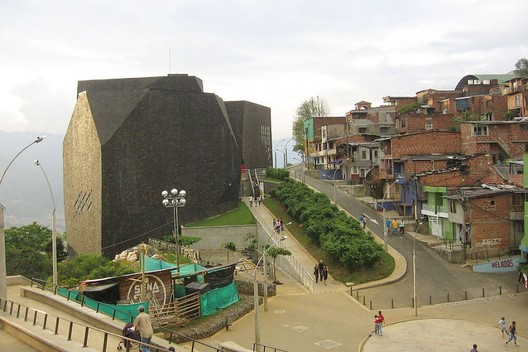 "Spain Library Park, Colombia, Medellín / Photo: en.wikipedia.org". Image Courtesy of Strelka Magazine "Spain Library Park, Colombia, Medellín / Photo: en.wikipedia.org". Image Courtesy of Strelka Magazine This posting includes an audio/video/photo media file: Download Now |
| EFFEKT's Winning Proposal Converts Abandoned Warehouse Into Cultural Hub Posted: 22 Jan 2017 10:00 PM PST  © EFFEKT © EFFEKT Copenhagen-based firm EFFEKT has won a competition to design a new Streetmekka in Viborg, Denmark, through the repurposing of an abandoned former windmill factory in the city's industrial sector. The winning proposal, aims to instill a newfound sense of identity and value into one of the many leftover warehouse buildings, in the form of a new cultural center for street art, sport, and culture. The Viborg Municipality and GAME, a Danish street sports NGO, announced that the competition's purpose was to enable social and cultural change, specifically through empowerment of local youth.  The skate-bowl. Image © EFFEKT The skate-bowl. Image © EFFEKT
With a focus on self-organization and empowerment, the building includes a number of facilities catered to street sports, while workshops, studios, and labs allow for music production.  The northern passage - "The Ditch". Image © EFFEKT The northern passage - "The Ditch". Image © EFFEKT Social gathering spaces are woven into the various programs, to enable collective cultural interaction and growth. These are also intended to help newcomers partake in spaces they may not have experienced before. An element of EFFEKT's design responds to the introverted nature of the typology of industrial buildings, which were typically constructed from prefabricated concrete panels or corrugated steel in the 1960s.  The central space - "The Street". Image © EFFEKT The central space - "The Street". Image © EFFEKT
The project's programmatic organization is based on the notion of an indoor streetscape, by blurring boundaries between the interior space and exterior urban environment, through the translucent envelope continuous activity of street sports, for example.  © EFFEKT © EFFEKT
Local artists are invited to use the building envelope to project and display their work, adding to cultural hub's constantly evolving character.  © EFFEKT © EFFEKT
Learn more about the project here. News via: EFFEKT. This posting includes an audio/video/photo media file: Download Now |
| You are subscribed to email updates from ArchDaily. To stop receiving these emails, you may unsubscribe now. | Email delivery powered by Google |
| Google Inc., 1600 Amphitheatre Parkway, Mountain View, CA 94043, United States | |


























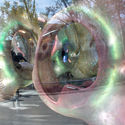

.jpg?1484705595)
.jpg?1484705575)
.jpg?1484705553)
.jpg?1484705357)


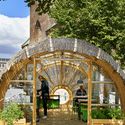
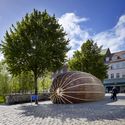
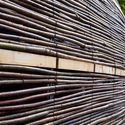
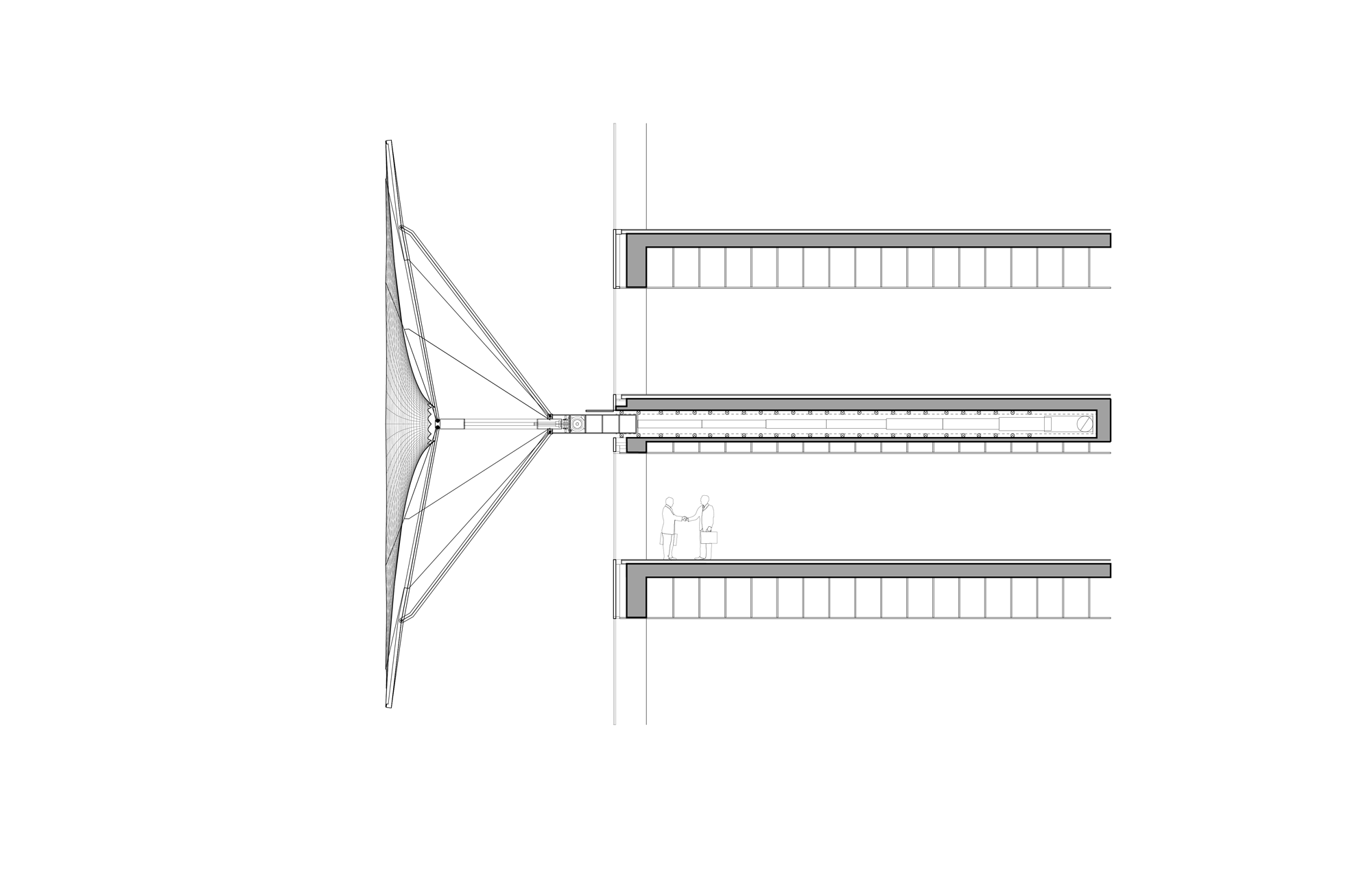





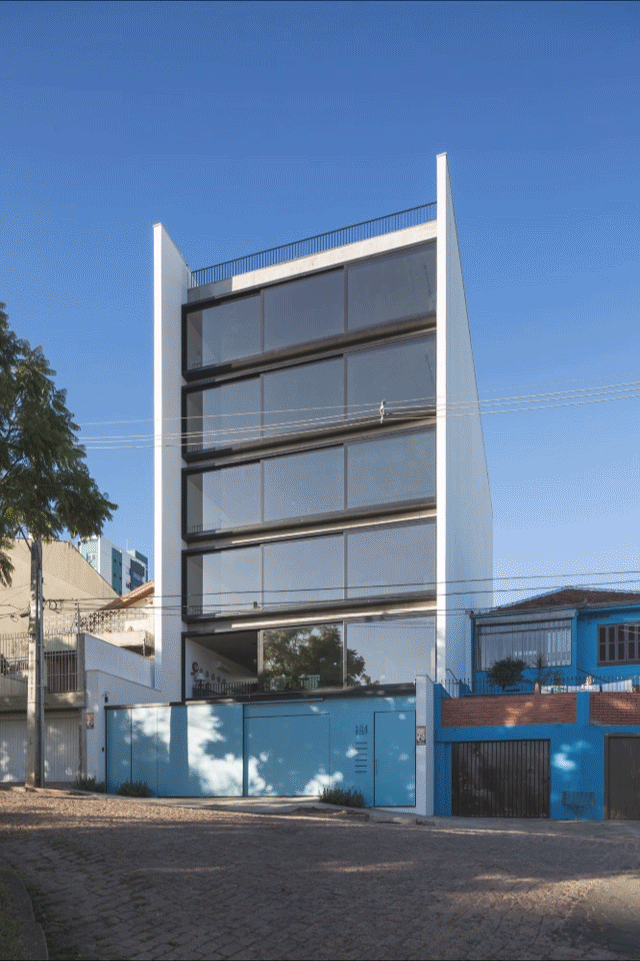

















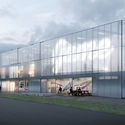


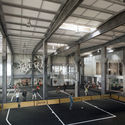
Nema komentara:
Objavi komentar